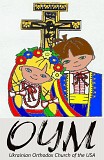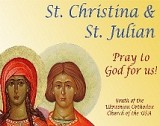History
Upon review of the needs of parishes in conjunction with several years of study, in 2014 the Consistory Office of Youth & Young Adult Ministry moved to a more holistic approach to youth ministry curriculum. Most parishes within the UOC of the USA are unable to support the traditional youth ministry format of separate programming and administration for religious education and youth group/ministry. The need for a more cohesive approach in the parishes coincided with the greater movement within Orthodox youth work recognizing the need for a different approach and ideology.
With these two factors in play, the OYM began offering a new format and approach for youth ministry curriculum. This approach was initially broken into three facets, traditional learning, praxis, and family support.
Ideology and Approach
The term, “It takes a village” might seem cliché, however, it harkens back to the very beginning of the Christian faith. Learning about and living the faith often came from the home and by extension the Christian community. In our modern ethos, the structure for youth to leave their homes for instruction in most aspects of life has become ingrained in our capacity for learning. If we are to attempt to “be a village” in the formation of our young people, then we need to work within the constraints of the modern ethos.
Firstly, who is the village? In the world of development, there is the theory of connectivity. You begin by placing your product or the focus of your need in the center of the bulls-eye. You then determine who is most connected to that center by degrees of proximity or buy-in and place them on each concentric circle that ripples from the bulls-eye. Once this exercise is complete, you then look at each circle and determine your approach to that group/individual based on their level and type of connectivity. The thing that binds these varying rings together is the target and the combined effort of all the rings will make the object of the bulls-eye successful.
If we use this approach, we can identify varying constituents who invest in the target, our youth. Who is the village for the youth of our parishes? Families, friends, mentors, teachers, parish family, and so on. Utilizing this approach, we may look more specifically at our youth programming and determine the individual youth programs of religious education, youth groups, basketball teams, and dance groups to name a few.
What does this have to do with spiritual formation of our youth and who is responsible for that formation?
Let us consider a sculptor and his creation. A sculptor begins with a block or lump of clay. They can often have a vision for the finished sculpture but the properties of each piece of clay are different. The conditions under which the sculpture works change – humidity, temperature, light. You must keep the clay pliable for it becomes more difficult to work as it dries.
As work begins, the sculptor molds, cuts, pushes and pulls. He has an array of tools for different purposes to form the clay in a specific way. Sometimes the way the clay begins to form isn’t right, so the sculptor goes back and gently works the clay in a new way to get it to the right place. It is a process, it takes times, it takes many different tools for the sculptor to form the sculpture into his vision. The end-product may not be exactly as the sculptor had envisioned. But the final form, hopefully, fulfills the expectation of the vision.
Spiritual formation is much like a sculptor and his clay. Christ is the sculptor and we, the members of the village, the members of His body, are some of the essential tools. Clergy, parents, families, parishes, and all limbs of youth work are contributing tools and techniques in forming the clay, in forming our youth.
How do we approach all the constituents to have them invested in the final product? How do we make the tools of the sculptor work in concert to form the clay into His image? This is the tricky question. This is where we need the continual assessment of our sculpture, does it need corrections, is it leaning too far to one side – what tool is needed where and when?
Creating a plan for ensuring that all members of the village are not only working to the same end but working together is essential. The curriculum approach we have been developing is one step in this process. Although this document is specifically address curriculum in it is vital to note that content of sessions and conveying that content is an important part of youth ministry. However, the time spent together, and relationships created and maintained are just as crucial. It is within this combination of worship, relationship, interaction, learning and living that our youth encounter Christ and deepen their relationship with Him and His church.
The need for cohesive effort in our youth ministry efforts has led us to the following approach:
Each curriculum is created around a main theme. This theme should carry through a year. The curriculum should be a main component when planning the over-all youth programming within the parish and additional components (fellowship events, retreats, outreach, etc.) should ideally complement the focus of the curriculum. We understand that this may not always be practical but should be taken into consideration. Even if actual elements of the theme cannot be incorporated, the spirit of the theme can be conveyed through the relationships within the community and tone of the events.
Traditional Learning – “It is not the amount of learning that must be our aim, but the quality of learning. Better to learn two verses with understanding than a whole page with wandering thoughts.” St. John Cassian
As mentioned earlier, our society has developed a culture of education that supports a classroom and shared learning experience outside of the home. Our youth want to learn, ask questions and explore. How we achieve this will change as teaching and learning techniques evolve. The Traditional Learning Sessions provided within our curriculum follow current trends in education. They encourage an active learning setting and try to encompass the four main learning methods – visual, auditory, reading/writing, and kinesthetic. These sessions would encompass what many would see as the traditional church school class setting.
Praxis Learning – “Let us raise our children in such as way they can face any trouble, and not be surprised when difficulties come; let us bring them up in the discipline and instruction of the Lord…When we teach our children to be good, to be gentle, to be forgiving, to be generous, to love their fellow men, to regard this present age as nothing, we instill virtue in their souls, and reveal the image of God within them. This, then is our task: to educate both ourselves and our children in godliness; otherwise what answer will we have before Christ’s judgment-seat?” St. John Chrysostom
Praxis in the view of the Orthodox church is the practice of living the faith. Fr. Joseph Purpura in his paper, Youth Ministry – Connecting Learning with Living in the Kingdom, describes youth ministry as “where theology for young people begins to come alive.” The Praxis Learning sessions could be seen as the traditional youth ministry/youth group component. The difference here is that these sessions have been created to directly support and expand upon the Traditional Learning Sessions. Thus, cohesively forming our youth to one purpose. The format of the sessions varies depending on the subject matter to potentially encompass worship, witness, stewardship, and fellowship. The important focus is to provide opportunity to live what they have learned.
Family Support – “Every Christian family ought to be as it were a little church consecrated to Christ, and wholly influenced and governed by His rule.” St John Chrysostom If we were to look at the first ring of connectivity to our target/youth, it would most definitely contain immediate family. We must include and invest the parents and immediate family of our youth in the process of formation. This is the final component of the curriculum and the component is still in development. The curriculum supports families by providing them with take home information to utilize in the home, supporting what has been learned and lived with the youth programming. The newest of the Praxis sessions have begun to include an element of family inclusion in the sessions to further promote the involvement and cohesion of the village.
Conclusion
It is our hope that in this format we will be able to evaluate the needs of our youth and their families and adapt the creation of curriculum as our communities evolve and grow in Christ. In this way, we hope to remain a vibrant tool in the spiritual formation of our youth. We in youth ministry may not complete the sculpture but we are essential in helping to form its base.
The Future
We hope to continue in our efforts to not only provide full resource curriculums but also stand-alone sessions and smaller plans so that parishes may tailor to the needs of their parish. We will also continue to join our Orthodox brothers and sisters in the exploration of spiritual formation and adapt our efforts in light of those discussions.
Please contact the Office of Youth & Young Adult Ministries for information on our curriculum, for parish consultations, or for youth worker training in these suggested techniques.
Downloadable version of this article.

